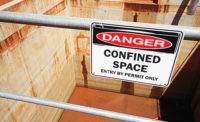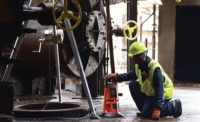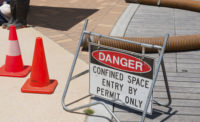As a consultant, you find yourself in a vast array of work environments. These may include underground utility vaults that have just experienced a “small” fire. Recently, I found myself in just such a scenario, working side by side with a utility worker crew preparing to enter a confined space to conduct a damage assessment. Our project was to evaluate the post-fire atmosphere of the underground street vault prior to the crew entering. It was standard operating procedure to conduct redundant readings from separate entities following this type of event and get agreement of a safe atmosphere prior to entry. Good practice.
Monitoring at a minimum
The utility crew was onsite first and had their four-gas meter (and forced ventilation) set up. [The four-gas meter is the go-to instrument at a minimum for any confined space atmosphere evaluation. Most are set up for measuring oxygen (%); combustible gas (% of the lower explosive limit); carbon monoxide level (ppm), and the hydrogen sulfide level (ppm).]
As I walked up, one of the crew said, “Hey no alarms, so it looks like we’re good to go.” I noted the readings on their four-gas meter being used to evaluate the space: CO – 18 ppm, H2S – 0 ppm, LEL 0 %, O2 -20.0 %. What is going on here?
I prepped my meter and dropped a line in for a side by side comparison. My meter read: CO – 10 ppm, H2S – 0 ppm, LEL - 0 %, Oxygen - 20.9 %. I also had the luxury of using a photoionization detector (PID) for volatile organic compounds (VOCs) – all readings were 0 ppm. Huh. The CO difference, although notable, was not the concern. What was concerning was the discrepancy in the two oxygen measurements. This significant difference needed to be resolved. A quick field check was performed by removing the hose line from the utility crew meter and taking a “fresh air” sample above the vault at street level. The CO dropped but the oxygen still read 20.0% on their meter.
Know your meter
I asked the worker when the last time this meter was calibrated. He answered, “Today.” I asked if it had been just bump tested or calibrated. “What’s the difference?” he said. This is not an unexpected answer — his main job is a utility guy. But shouldn’t he have a greater understanding of the meter he is using?
According to the International Safety Equipment Association (ISEA), the following definitions maintain consistency in terminology when referring to gas monitoring equipment:
Bump Test (Function Check) — A qualitative function check where a challenge gas is passed over the sensor(s) at a concentration and exposure time sufficient to activate all alarm indicators to present, at least their lower alarm setting. The purpose of this check is to confirm that gas can get to the sensor(s) and that all the alarms present are functional. This is typically dependent on the response time of the sensor(s) or a minimum level of response achieved, such as 80% of gas concentration applied. Note this check is not intended to provide a measure of calibration accuracy.
Calibration Check — A quantitative test utilizing a known traceable concentration of test gas to demonstrate that the sensor(s) and alarms respond to the gas within manufacturer’s acceptable limits. This is typically ±10-20% of the test gas concentration applied unless otherwise specified by the manufacturer, internal company policy, or a regulatory agency.
Full calibration — The adjustment of the sensor(s) response to match the desired value compared to a known traceable concentration of test gas. This should be done in accordance with the manufacturer's instructions.
Situation resolved
In the utility vault scenario, we concluded that the meter the crew was using probably had a bad oxygen sensor. A third four-gas meter was brought to the site and confirmed normal oxygen levels in the vault. Within a few minutes of forced ventilation, the residual CO was gone and the situation was resolved.
But not so fast…
So what if my meter had also shown 20.0 % oxygen? Would we have been “good to go” as he had thought? There would have been no visible or audible indicators on the instrument (lights flashing or alarms sounding), but there should still have been an alarm ringing in our heads. Here is why:
Fresh air contains only 20.9% oxygen by volume. The balance consists mostly of nitrogen, with minor or trace concentrations of a wide variety of other gases. Because oxygen represents only about one-fifth of the total volume of fresh air, every 5% of a displacing gas that is introduced into a confined space reduces the oxygen concentration by about 1%. Therefore, in this case, we have a displacement of 0.9% oxygen. Not enough to be oxygen-deficient according to OSHA or set off a factory setting low oxygen alarm. But a quick estimate indicates we have an unknown gas or gasses present to the tune of about 45,000 ppm.
• 0.9 % oxygen displacement X 5 since oxygen is only one fifth of normal air= 4.5%
• Knowing that 1% gas concentration converts to 10,000 ppm
• 4.5% X 10,000 = 45,000 ppm of an unknown gas or gases that have displaced the air and thus reduced the oxygen level by 0.9%.
We would not be “good to go” for entry.
Upon further review
A further evaluation of the environment with additional “tools” would be warranted. A photoionization detector (PID) would likely be the next “tool” we would use to help evaluate the situation (a subject best left for another article). This demonstrates how the oxygen level can be used as a key indicator of other potential contaminant concentrations in a confined space and not just provide a safe range for breathing air. This is referred to as using your oxygen sensor as a broad band toxic detector.
A second case study
To further emphasize this point, at another job site there was an accidental release of a carbon dioxide fire suppression system into a two-story structure. The building housed electric utility equipment. It was a brick building with no windows and only a few access doors. The building needed to be ventilated to exhaust the carbon dioxide and return the atmosphere to normal air. The problem was that the one and only exhaust fan switch was inside the building.
Eventually an entry was made using self-contained breathing apparatus (SCBAs) to evaluate the building interior atmosphere and to assist in ventilating the building. The concentration of carbon dioxide was estimated based on the oxygen deficiency measured by the four-gas meter. In this case, due to the known release of carbon dioxide, it was a pretty good estimate. Most readings indicated a reduced oxygen level (around 20% + 0.1%), but not an oxygen-deficient atmosphere (less than 19.5%) according to OSHA and not at a level that would set the meter into “alarm.” We were “good to go” to remove our SCBAs, right? Wrong.
Even though carbon dioxide is a simple asphyxiant and the main concern in the situation was oxygen deficiency, NIOSH has established an Immediately Dangerous to Life or Health (IDLH) level at 40,000 ppm for carbon dioxide. From what we just reviewed using the oxygen sensor as a broad band toxic detector, are we below the IDLH level with our oxygen measurements of 20%+ 0.1%? No, and here is why:
• 40,000 ppm (the carbon dioxide IDLH value) = 4.0% carbon dioxide
• How much oxygen would be displaced if there was 40,000 ppm carbon dioxide in an atmosphere? In other words, what would the oxygen reading be on a four-gas meter oxygen sensor in this atmosphere? As discussed above, oxygen is only on fifth of normal air, so we need to divide by 5 first. (4.0% divided by 5 = 0.8 % oxygen displacement)
• 20.9% normal air minus 0.8% displacement by 40,000 ppm of carbon dioxide = 20.1% reading on the four-gas meter.
• So 40,000 ppm of carbon dioxide (IDLH level) equates to roughly 20.1 % oxygen reading and our readings were lower than that -- the carbon dioxide concentration was in excess of the the IDLH.
Even though the four-gas meter was indicating an atmosphere that was not oxygen-deficient (no alarms), knowing that the displacing gas was carbon dioxide, there was still a potential toxic hazard present at an IDLH level.
Conclusion
Admittedly, this is not easy stuff, especially if you are not a consistent user and student of the four-gas meter. This article touched on only a couple of oxygen sensor issues that can arise in the use of a four-gas meter. Many more topics come into play: understanding all sensors’ operation, range, resolution, response time, temperature and moisture affects; calibration gas type; the list goes on.
A clear and thorough knowledge of all the sensors and information they provide (and do not provide) is needed to truly make an informed decision of a confined space atmosphere. Do your workers use their four-gas meter as “go-no-go” safety device or as a true tool that provides more than alarm warnings?



